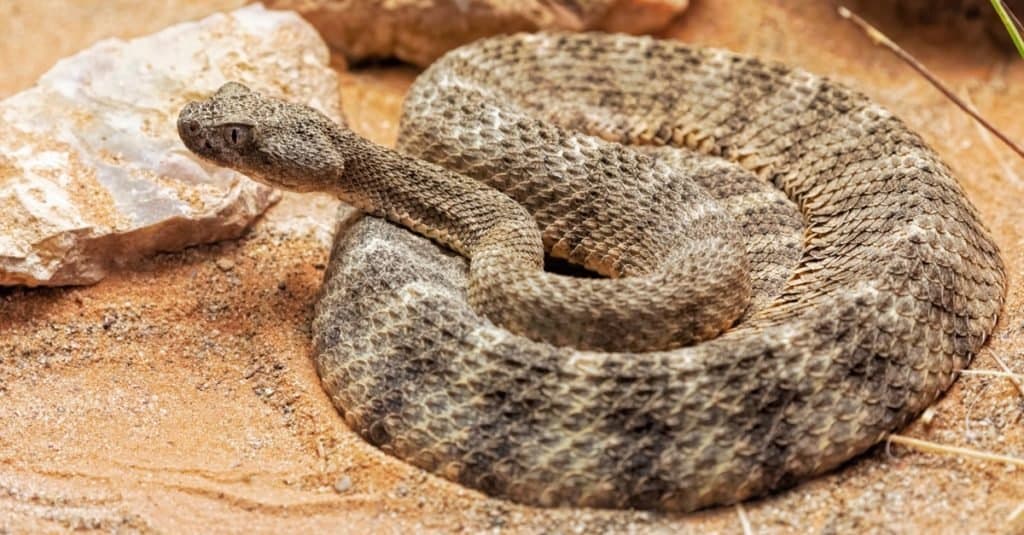Regarded by many as the most venomous rattlesnake in the world, the tiger rattlesnake is a specialized predator with outrageously toxic venom. This snake lives in southern Arizona and parts of northern Mexico and spends most of its time searching through rocky crevices for small mammals like kangaroo rats to eat.
While you might think one of the diamondback rattlers would have the most dangerous venom, they don’t. They are capable of delivering vast quantities of venom, making them very dangerous. However, their venom isn’t the most toxic in the world.
Tiger rattlesnakes are a somewhat cranky species, but because of the remote areas where it lives, not many people see or have been bitten by them. Tiger rattlesnakes have the smallest head of any rattlesnake, which is handy if you shove your head in after a rodent tries to make an escape into the rocks.
While mountain lions look fluffy and cuddly, they are apex predators — an extremely successful species that live throughout most of the Americas. Nearly as solitary as the tiger rattlesnake, mountain lions usually roam huge territories.
So what might happen if two deadly predators faced off? In this totally imaginary but equally possible scenario, we examine whether a mountain lion or the most venomous rattlesnake in the world will win in a fight.
Comparing the Tiger Rattlesnake and Mountain Lion

Maybe it’s a little silly to compare a tiger rattlesnake and a mountain lion’s characteristics — especially considering how different the species are from one another. Yet, how else do we decide who would win in a fight?
| Tiger Rattlesnake | Mountain Lion | |
|---|---|---|
| Size | Weight: Up to 1 lb Length: 2-4 ft | Weight: 64-220 lbs Length: 6-8 ft Height: 2-3 ft |
| Speed & Movement Type | — 2.5 mph — Slithering — Leaping strike, up to 1/2 body length — Excellent swimmer — Climbs bushes | — 50 mph sprints — Vertical jumps up to 18 ft — Horizontal jumps up to 40 ft |
| Defenses | — Camouflage helps tiger rattlesnakes hide — Fangs & venom — Large rattle for warnings | — Coat color helps them camouflage — Powerful forelegs and claws — Big canines and strong bite |
| Offensive Capabilities | — Fangs deliver extremely toxic venom directly into the body — Super quick strike | — Sharp claws and large front feet for holding prey — Big teeth in jaws with 350 psi bite force — Excellent vision |
| Predatory Behavior | — Ambush predator, sits waiting for prey for days — Active hunter, searching rocky crevices for prey | — Stalks prey, sometimes for hours — Tries to ambush most prey — Uses speed to catch food |
Key Differences Between Tiger Rattlesnakes and Mountain Lions

Tiger rattlesnakes have smaller heads than other rattlesnakes.
©DnDavis/Shutterstock.com
These predators have massive differences — they aren’t even close to the same size! Tiger rattlesnakes are highly specialized reptiles that use their smaller size and camouflage to their advantage. However, that leaves them at a distinct disadvantage against a mountain lion. When you add that to their other differences, like legs, it’s clear that the mountain lion has an advantage.
Another difference between tiger rattlesnakes and mountain lions is venom. The tiger rattlesnake has the most potent venom of any rattlesnake in the world, but mountain lions don’t have such a weapon. This may leave the mountain lion at a disadvantage.
Key Factors in a Fight Between a Tiger Rattlesnake vs. Mountain Lion
Every imaginary death match has to have some pre-fight analysis, and this is no exception. We’re looking at every angle to figure out which animal would come out on top in a fight.
Tiger Rattlesnake vs. Mountain Lion: Size
Tiger rattlesnakes will never weigh more than about a pound. They’re not the smallest rattlesnake in the world, but they’re not very big. Most will never exceed three feet long, whereas a big male mountain lion can weigh over 200 pounds.
The size advantage goes to the mountain lion.
Tiger Rattlesnake vs. Mountain Lion: Speed and Movement
Small but dangerous, tiger rattlesnakes can move surprisingly quickly. Delivering their deadly bite with a lightning-quick strike, these snakes can kill their opponent. Mountain lions have the grace and agility of their feline family behind them, giving these solitary predators a huge advantage.
Defenses
If it weren’t for the nasty bite they offer, the snakes wouldn’t stand a chance against a mountain lion. These snakes have the most toxic venom of any rattlesnake and aren’t afraid to use it. Their mountain lion opponents have an arsenal of weapons, including large front feet and claws. Also notable is that cats tend to have some resistance to snake venom, and they reach out with paws to investigate rather than getting a full snoot of snake-scented air.
Tiger rattlesnakes use their habitat to their advantage and can slide into small crevices to hide from predators. Mountain lions can leap up to 40 feet horizontally and 18 vertically; they can also run up to 50 miles per hour to escape threats.
Offensive Weapons
With a bite force of 350 pounds per square inch (PSI) and massive strength, the mountain lion is an impressive contender in this fight. The big cat ambushes prey and bites down on its neck from the back, breaking the animal’s neck in the process. More cautious in their approach to feeding, tiger rattlesnakes tend to wait for prey to walk close enough to strike, biting and releasing to follow it while the animal dies.
Tiger rattlesnake venom has a median lethal dose of .06 milligrams per kilogram of body weight, and it can produce six to 11 milligrams per bite. That’s a lot of danger for such a tiny amount of venom. Still, felines have different blood than humans or canines and have a better survival chance against snakebites.
Behavior
Shy and somewhat reclusive, tiger rattlesnakes try to avoid confrontation whenever possible. As deadly as their venom is, their best defensive behavior is avoiding the mountain lion entirely. The tiger rattlesnake would most likely attempt a retreat to a crevice where the big cat can’t reach and strike from there.
In a manner similar to our house cats, the mountain lion will swat at the snake while trying to avoid its bite. They’ll probably wear the snake out by batting at it repeatedly with a paw. And, even if the snake lands a solid bite, the mountain lion may still survive.
Who Would Win: Tiger Rattlesnake vs. Mountain Lion
In a fight between a tiger rattlesnake and a mountain lion, even if the snake wins, it loses to the bigger and more powerful mountain lion. Venom takes time to act on its victim, so the mountain lion has time to finish off the snake. In the end, the mountain lion is too much for even the dangerous tiger rattlesnake to win. It’s an unfortunate truth for snakes of nearly all species — they’re prey for all bigger predators!

Against a tiger rattlesnake, the mountain lion would most likely come out on top.
©Evgeniyqw/Shutterstock.com
Another Animal that Can Take Down a Tiger Rattlesnake: Golden Eagles
Birds of prey like golden eagles, hawks, and owls regularly take on all kinds of snakes — venomous or not. The golden eagle’s massive wingspan and powerful claws mean death from above for the tiger rattlesnake. However, the eagle would have to time it perfectly because if the snake managed to turn around and bite the golden eagle, the bird would not survive the encounter.
There have been a few cases where a snake and an eagle or hawk were found on the ground, dead after an apparent death match. We think that if the snake got a good bite in early enough, it might survive, but it’s not likely. So, here again, even if the tiger rattlesnake wins, it loses to the golden eagle!
The photo featured at the top of this post is ©
Thank you for reading! Have some feedback for us? Contact the AZ Animals editorial team.






